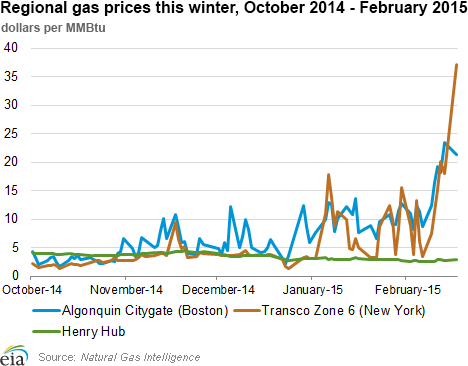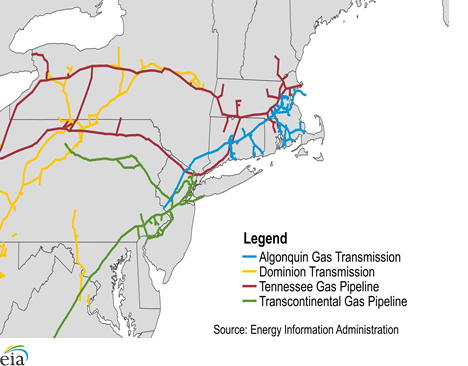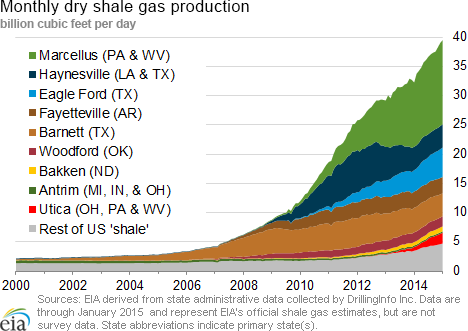In the News:
Northeast gas demand hits record high on Monday
Natural gas demand in the northeastern United States hit 43.1 billion cubic feet (Bcf) on Monday, according to Bentek Energy. This is the highest level in Bentek's 10-year history, and exceeded the previous high set during last year's polar vortex by 1.2 Bcf in January 2014. Low temperatures in the Northeast over the weekend and into the week also led to price spikes and pipeline constraints. Prices jumped at the Algonquin pricing point, which serves Boston-area consumers. On Friday, February 13, prices spiked to $23.51/MMBtu heading into the three-day weekend, reflecting expectations for high demand in an area that has already been hammered by several recent snowstorms. Prices at Algonquin eased slightly on Tuesday, but prices at Transco's Zone 6 delivery point into New York City jumped to $37.04/MMBtu on Tuesday and then to $38.15/MMBtu on Wednesday, its highest level this winter, likely reflecting forecasts for more cold weather to come. Bentek projects demand tomorrow could reach a record high, as forecasted low temperatures for many areas in the Northeast are in the single digits and teens. Demand is expected to fall this weekend as temperatures remain cold, but rise to more normal levels. While prices this week have spiked, the prolonged severe winter of 2013-14 led to much higher increases, with prices rising above $100/MMBtu at Transco Zone 6 and $78/MMBtu at Algonquin.
Algonquin Gas Transmission (AGT) announced several capacity constraints on various parts of its system throughout the weekend; AGT restricted interruptible nomination and 91% of secondary out-of-path nominations (i.e., outside of the path of the contracted primary firm receipt point) on its system to points west of Stony Point, New York. Transcontinental Pipeline also limited interruptible capacity on its system. Additionally, an unplanned shutdown of a compressor station on Dominion Transmission Inc.'s (DTI) system led the company to declare a force majeure (which frees both parties from upholding contractual obligations in the event of extraordinary circumstances). DTI's force majeure affected primary deliveries to several points in New York, including its interconnection with Tennessee Gas Pipeline in Morrisville.
Pipeline imports from Canada to the Northeast and LNG sendout also increased this week, as producers likely took advantage of the high regional prices in the Northeast. Imports into the Northeast were up 15% from the previous week, and up 41.4% from the same week last year. LNG sendout rose to 1.7 Bcf, with sendout coming from Cove Point in Maryland and Everett outside of Massachusetts, as well as Elba Island in Georgia.
Overview:
(For the Week Ending Wednesday, February 18, 2015)
- Natural gas prices were mixed in the Wednesday to Wednesday report week, with regions east of the Rockies experiencing extreme winter weather and those west of the Rockies experiencing more moderate conditions. The Henry Hub spot price dropped modestly at midweek, but rose overall for the report week, closing at $2.93/MMBtu on Wednesday, February 18.
- At the New York Mercantile Exchange (Nymex), the price of the near-month (March 2015) contract started the report week at $2.797/MMBtu last Wednesday and moved up to settle at $2.831/MMBtu yesterday.
- Working natural gas in storage decreased to 2,157 Bcf as of Friday, February 13, according to the U.S. Energy Information Administration (EIA) Weekly Natural Gas Storage Report (WNGSR). A net withdrawal from storage of 111 Bcf for the week resulted in storage levels 45.8% above year-ago levels and 2.8% above the five-year average for this week.
- The total U.S. rig count continued to fall this week, dropping 98 units to 1,358 active units, 406 below the year-ago count, according to data reported by Baker Hughes Inc. The natural gas rig count fell by 14 units to 300, while the oil rig count fell by 84 units to 1,056. The largest decline occurred in the Permian Basin, where rigs fell by 49 units. Two miscellaneous units remained in service.
- The natural gas plant liquids composite price rose 2.9%, a 16¢ increase for the week ending February 18, from $5.36/MMBtu to $5.52/MMBtu from Friday to Friday. With the exception of butane, which fell 0.6%, Mont Belvieu NGL spot prices rose this week, with natural gasoline rising 1.8%, ethane up 3.1%, propane up 5.8%, and isobutane up 0.4%.
Prices/Demand/Supply:
Prices rise as temperatures fall. During the report week, temperatures in the eastern half of the United States dropped to their coldest yet for this winter. After falling from $2.85/MMBtu at the start of the report week to $2.73/MMBtu on Friday, prices at the Henry Hub rose 22¢on Tuesday, with the approaching cold weather. The Henry Hub spot price ended the week at $2.93/MMBtu yesterday. Despite the Wednesday to Wednesday increase, Henry Hub prices, supported by production that is 11.6% above the same time last year, remain relatively low, even with forecasts for continuing cold weather. Prices increased on Wednesday in the Midwest, with high temperatures forecast in the single digits for Thursday. Driven by an increase of $7.57/MMBtu on Wednesday, Chicago Citygate more than tripled in price Wednesday to Wednesday, starting at $3.14/MMBtu and moving up to $11.51/MMBtu yesterday.
Northeast and Mid-Atlantic see new seasonal high prices. The Northeast and the Mid-Atlantic trading hubs started the week cold and got colder. Prices at trading locations serving these major market areas started the report week at seasonal highs that were surpassed during the report week. At the Algonquin Citygate, serving Boston, prices began the week at $19.27/MMBtu, then headed up to $23.51/MMBtu for the weekend, settling yesterday at $21.37/MMBtu. At Transcontinental Pipeline Zone 6, the trading point for New York City, prices began the week at $15.22/MMBtu, rising to end the report week at $38.15/MMBtu, a new high for this winter.
The western half of the United States experienced moderate temperatures during the report week, which have contributed to lower-than-average storage withdrawals and prices that have remained comparatively stable. For example, prices at PG&E Citygate, serving Northern California, fell from $3.03/MMBtu to $2.96/MMBtu during the report week.
Marcellus-area prices fall slightly through the week. Marcellus-area prices fluctuated slightly through the week, closing down yesterday by 10¢ or less. Prices at Tennessee's Zone 4 Marcellus began the week at $1.61/MMBtu last Wednesday, fell to $1.27/MMBtu by Friday, February 13, then rose to settle at $1.50/MMBtu yesterday. At the Transcontinental Leidy Line, which represents deliveries into several pipeline systems in the upper west-central portion of Pennsylvania, prices started the week at $1.67/MMBtu last Wednesday, dipped 25¢ to $1.42/MMBtu on Friday, and then rose to $1.63/MMBtu at the end of the report week. Prices at Dominion South rose from $2.83/MMBtu last Wednesday to $3.03/MMBtu on Tuesday, but fell to close down yesterday at $2.82/MMBtu.
Nymex prices rise. Near-month Nymex prices fluctuated some during the report week, starting at $2.797/MMBtu last Wednesday and moving to $2.831/MMBtu yesterday. The price of the 12-month strip (the average of the 12 contracts between March 2015 and February 2016) rose from $2.910/MMBtu last Wednesday to $2.949/MMBtu yesterday.
Demand rises significantly for the week. With increases in all sectors, domestic consumption rose 23.1% this report week. Led by severe winter weather sweeping into the Midwest and pushing south and east, U.S. residential/commercial consumption rose 36.5% week over week, and consumption of natural gas for electric power generation (power burn) increased 14.5%. Despite decreased power burn in the Pacific Northwest, Rockies, and Southwest regions, all of the other regions, among them the largest power burn consumers, saw significant increases over the Wednesday to Wednesday report week. Industrial consumption of natural gas was 4.4% higher, while exports to Mexico fell 3% this week. Total demand was 21.3% more than this time last year.
Supply rises. Total natural gas supply rose 1.4%, driven by an 11.3% increase in imports from Canada over the previous week, and an increase in LNG sendout, which exceeded its weekly five-year (2010-14) average, the first time this has happened since March 2010. Although domestic production of dry natural gas fell slightly for the week, it remains more than 11.6% higher than this time last year with an average of more than 72.8 billion cubic feet per day (Bcf/d).
Storage
Storage inventories surpass five-year average. For the first time since November 22, 2013, natural gas inventories were higher than their five-year average, although this situation may only last a week. Following a net withdrawal of 111 Bcf for the week, working gas inventories as of February 13 totaled 2,157 Bcf, 678 Bcf (45.8%) higher than last year at this time and 58 Bcf (2.8%) higher than the five-year (2010-14) average. The 111 Bcf net withdrawal reported for the week was lower than both the five-year average and last year's net withdrawals for the week ending February 13, which were 180 Bcf and 247 Bcf, respectively.
Colder-than-normal temperatures may drive inventories back below five-year average. Record-setting cold temperatures in the eastern half of the United States are driving early market expectations of a storage withdrawal that will be more than 200 Bcf for the week ending February 20. A net withdrawal in excess of 131 Bcf for this week will bring storage levels back below their five-year average.
Storage withdrawals are in line with market expectations. Market expectations, on average, called for a pull of 110 Bcf. When the EIA storage report was released at 10:30 a.m. on February 19, the price for the March natural gas futures contract increased 1.5¢, to $2.85/MMBtu, in trading on the Nymex. In the next hour, prices decreased slightly, trading around $2.83/MMBtu.
Stocks in the West and Producing Salt region drive surplus to five-year average. With the Producing region now above its five-year average, only the East region remains lower than that metric. The growth in the Producing region over the five-year average is driven by the salt facilities in that region, which are now 80 Bcf, or 56.3% higher, than their five-year average. Nonsalt facilities in the Producing region remain below their five-year average by 54 Bcf (8.6%). The West region is above its five-year average level by 60 Bcf. Storage levels for the East, West, and Producing regions were above their year-ago levels by 281 Bcf, 142 Bcf, and 256 Bcf, respectively. The East and Producing regions had net withdrawals of 97 Bcf (4 Bcf lower than its five-year average withdrawal) and 18 Bcf (43 Bcf lower). Inventories in the West increased by 4 Bcf, compared to their five-year average withdrawal of 18 Bcf.
Temperatures during the storage report week are warmer than normal. Temperatures in the Lower 48 states averaged 38.0° for the storage report week, 2.6° warmer than the 30-year normal temperature and 12.3° warmer than the average temperature during the same week last year. There were 190 population-weighted heating degree days during the storage report week, 19 fewer than the 5-year average and 86 fewer than during the same period last year.
See also:
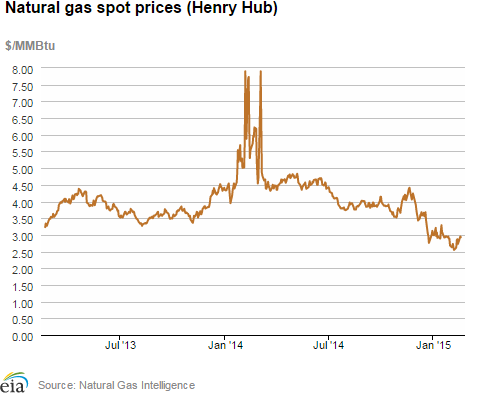
| Spot Prices ($/MMBtu) | Thu, 12-Feb |
Fri, 13-Feb |
Mon, 16-Feb |
Tue, 17-Feb |
Wed, 18-Feb |
|---|---|---|---|---|---|
| Henry Hub |
2.87 |
2.73 |
Holiday |
2.95 |
2.93 |
| New York | 20.06 |
18.06 |
Holiday |
37.04 |
38.15 |
| Chicago | 3.02 |
3.03 |
Holiday |
3.94 |
11.51 |
| Cal. Comp. Avg,* |
2.73 |
2.56 |
Holiday |
2.75 |
2.75 |
| Futures ($/MMBtu) | |||||
| March Contract | 2.713 |
2.804 |
Holiday |
2.759 |
2.831 |
| April Contract | 2.733 |
2.812 |
Holiday |
2.779 |
2.857 |
| *Avg. of NGI's reported prices for: Malin, PG&E citygate, and Southern California Border Avg. | |||||
| Source: NGI's Daily Gas Price Index | |||||
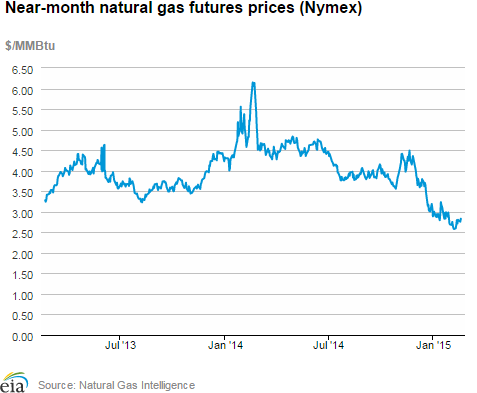
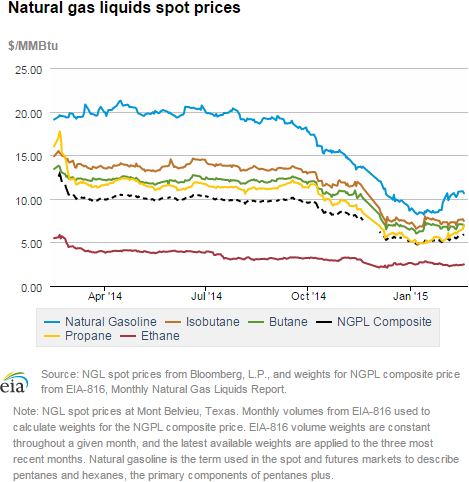
| U.S. natural gas supply - Gas Week: (2/11/15 - 2/18/15) | ||
|---|---|---|
Percent change for week compared with: |
||
last year |
last week |
|
| Gross production | 11.69%
|
-0.03%
|
| Dry production | 11.58%
|
-0.03%
|
| Canadian imports | 10.69%
|
11.28%
|
| West (net) | -0.65%
|
6.16%
|
| Midwest (net) | 6.63%
|
18.38%
|
| Northeast (net) | 41.41%
|
15.02%
|
| LNG imports | 267.35%
|
91.44%
|
| Total supply | 12.62%
|
1.44%
|
| Source: BENTEK Energy LLC | ||
| U.S. consumption - Gas Week: (2/11/15 - 2/18/15) | ||
|---|---|---|
Percent change for week compared with: |
||
last year |
last week |
|
| U.S. consumption | 21.2%
|
23.1%
|
| Power | 29.3%
|
14.5%
|
| Industrial | 3.5%
|
4.4%
|
| Residential/commercial | 26.5%
|
36.5%
|
| Total demand | 21.3%
|
22.5%
|
| Source: BENTEK Energy LLC | ||
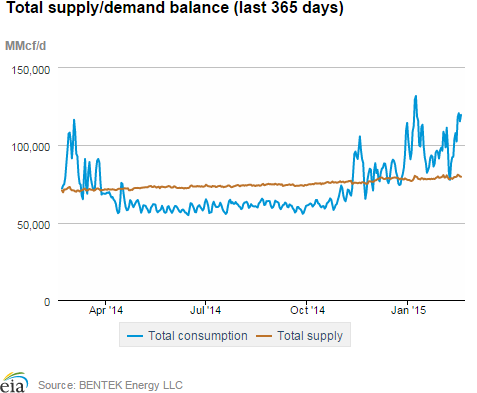
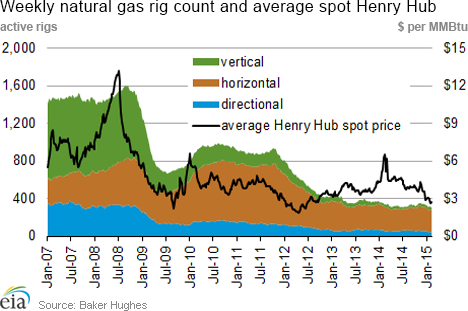
| Rigs | |||
|---|---|---|---|
Fri, February 13, 2015 |
Change from |
||
last week |
last year |
||
| Oil rigs | 1,056 |
-7.37% |
-25.79% |
| Natural gas rigs | 300 |
-4.46% |
-10.98% |
| Miscellaneous | 2 |
0.00% |
-50.00% |
| Rig numbers by type | |||
|---|---|---|---|
Fri, February 13, 2015 |
Change from |
||
last week |
last year |
||
| Vertical | 210 |
-9.87% |
-44.74% |
| Horizontal | 1,025 |
-5.79% |
-13.36% |
| Directional | 123 |
-8.89% |
-38.81% |
| Source: Baker Hughes Inc. | |||
| Working gas in underground storage | ||||
|---|---|---|---|---|
Stocks billion cubic feet (bcf) |
||||
| Region | 2015-02-13 |
2015-02-06 |
change |
|
| East | 984 |
1,081 |
-97 |
|
| West | 375 |
371 |
4 |
|
| Producing | 798 |
816 |
-18 |
|
| Total | 2,157 |
2,268 |
-111 |
|
| Source: U.S. Energy Information Administration | ||||
| Working gas in underground storage | |||||
|---|---|---|---|---|---|
Historical comparisons |
|||||
Year ago (2/13/14) |
5-year average (2010-2014) |
||||
| Region | Stocks (Bcf) |
% change |
Stocks (Bcf) |
% change |
|
| East | 703 |
40.0 |
1,012 |
-2.8 |
|
| West | 233 |
60.9 |
315 |
19.0 |
|
| Producing | 542 |
47.2 |
772 |
3.4 |
|
| Total | 1,479 |
45.8 |
2,099 |
2.8 |
|
| Source: U.S. Energy Information Administration | |||||
| Temperature -- heating & cooling degree days (week ending Feb 12) | ||||||||
|---|---|---|---|---|---|---|---|---|
HDD deviation from: |
CDD deviation from: |
|||||||
| Region | HDD Current |
normal |
last year |
CDD Current |
normal |
last year |
||
| New England | 320
|
53
|
-8
|
0
|
0
|
0
|
||
| Middle Atlantic | 276
|
22
|
-50
|
0
|
0
|
0
|
||
| E N Central | 281
|
3
|
-119
|
0
|
0
|
0
|
||
| W N Central | 252
|
-32
|
-159
|
0
|
0
|
0
|
||
| South Atlantic | 164
|
-4
|
-41
|
2
|
-5
|
-5
|
||
| E S Central | 162
|
-5
|
-73
|
0
|
0
|
0
|
||
| W S Central | 81
|
-36
|
-120
|
4
|
0
|
4
|
||
| Mountain | 117
|
-93
|
-114
|
2
|
1
|
2
|
||
| Pacific | 51
|
-55
|
-51
|
0
|
0
|
0
|
||
| United States | 190
|
-18
|
-86
|
1
|
0
|
0
|
||
|
Note: HDD = heating degree-day; CDD = cooling degree-day Source: National Oceanic and Atmospheric Administration | ||||||||
Average temperature (°F)
7-Day Mean ending Feb 12, 2015
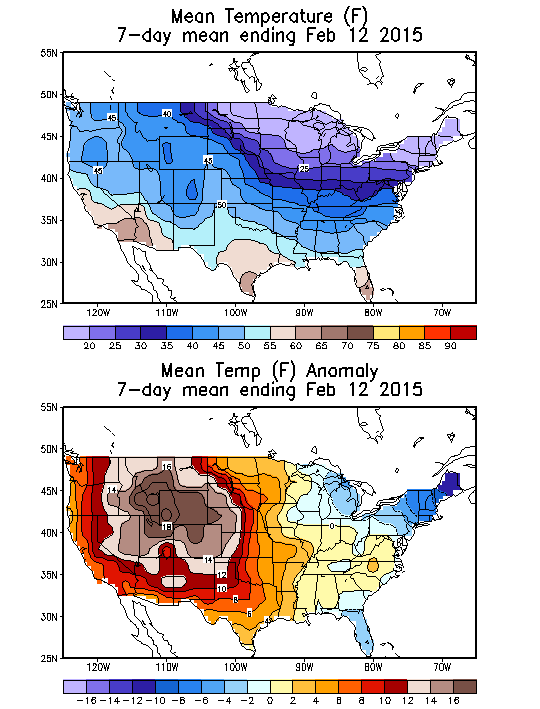
Source: NOAA/National Weather Service
Deviation between average and normal (°F)
7-Day Mean ending Feb 12, 2015

Source: NOAA/National Weather Service

